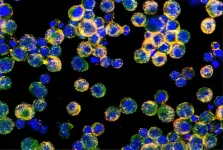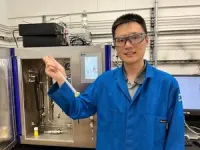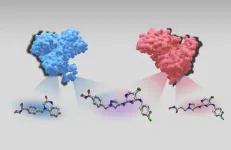(Press-News.org) Weill Cornell Medicine researchers have discovered a mechanism that ovarian tumors use to cripple immune cells and impede their attack—blocking the energy supply T cells depend on. The work, published Oct. 23 in Nature, points toward a promising new immunotherapy approach for ovarian cancer, which is notoriously aggressive and hard to treat.
A significant obstacle in treating ovarian cancer is the tumor microenvironment—the complex ecosystem of cells, molecules and blood vessels that shields cancer cells from the immune system. Within this hostile environment, T cells lose their ability to take up the lipid (fat) molecules, which are necessary for energy to mount an effective attack.
“T cells rely on lipids as fuel, burning them in their mitochondria to power their fight against pathogens and tumors,” explained senior author, Dr. Juan Cubillos-Ruiz, The William J. Ledger, M.D., Distinguished Associate Professor of Infection and Immunology in Obstetrics and Gynecology at Weill Cornell Medicine. “However, the molecular mechanisms that govern this critical energy supply are still not well understood.”
Identifying How Tumors Block T Cell Energy Supply
Lipids are abundant in ovarian tumors, but T cells seem unable to utilize them in this environment. “Researchers have focused on a protein called fatty acid-binding protein 5, or FABP5, which facilitates lipid uptake, but its exact location within the T cell remained unclear,” said Dr. Sung-Min Hwang, a postdoctoral associate in Dr. Cubillos-Ruiz’s lab who led the new study. Dr. Hwang discovered that in patient-derived tumor specimens and mouse models of ovarian cancer, FABP5 becomes trapped inside the cytoplasm of T cells instead of moving to the cell surface, where it would normally help take up lipids from the surroundings.
“That was the ‘aha!’ moment; since FABP5 is not getting to the surface, it couldn’t bring in the lipids necessary for energy production. But we still needed to figure out why,” said Dr. Cubillos-Ruiz, who is also co-leader of the Cancer Biology Program in the Sandra and Edward Meyer Cancer Center at Weill Cornell Medicine.
Working with collaborators, the researchers used a battery of biochemical assays to identify proteins that bind to FABP5. They found a protein called Transgelin 2 that interacts with FABP5 and helps move it to the cell surface.
Further experiments revealed that ovarian tumors suppress the production of Transgelin 2 in infiltrating T cells. Delving deeper, the researchers discovered that the transcription factor XBP1, which is activated by the stressful conditions within the tumor, represses the gene encoding Transgelin 2. Without Transgelin 2, FABP5 is trapped in the cytoplasm of T cells, preventing lipid uptake and rendering the T cells unable to attack the tumor.
Designer Immunotherapies to Overcome Tumor Defenses
With this fundamental mechanism worked out, the team explored an immunotherapy called chimeric antigen receptor T (CAR T) cells. This approach collects a patient’s T cells, engineers them to attack tumor cells and then injects the designer cells into the patient. “CAR T cells work well against hematological cancers like leukemia and lymphoma, but they’re really not effective for solid tumors like ovarian or pancreatic cancers,” Dr. Cubillos-Ruiz said.
When Dr. Hwang and his colleagues tested CAR T cells, which are currently being evaluated in clinical trials, in mouse models of metastatic ovarian cancer, they found the same problem—Transgelin 2 repression and impaired lipid uptake. Just like normal T cells in the tumor microenvironment, the engineered CAR T cells had FABP5 tangled in the cytoplasm. As a result, the CAR T cells were unable access lipids for energy to effectively attack the tumor, highlighting a critical barrier in using this immunotherapy for solid tumors like ovarian cancer.
To solve the problem, the researchers inserted a modified Transgelin 2 gene that couldn’t be blocked by stress transcription factors, so expression of the critical protein was preserved. This allowed Transgelin 2 to chaperone FABP5 to the surface of the CAR T cells where it could take up lipids.
Indeed, the upgraded T cells were much more effective in attacking ovarian tumors than the original CAR T cells. “Our findings reveal a key mechanism of immune suppression in ovarian cancer and suggest new avenues to improve the efficacy of adoptive T cell immunotherapies in aggressive solid malignancies,” Dr. Cubillos-Ruiz said.
Many Weill Cornell Medicine physicians and scientists maintain relationships and collaborate with external organizations to foster scientific innovation and provide expert guidance. The institution makes these disclosures public to ensure transparency. For this information, please see profile for Dr. Juan Cubillos-Ruiz.
This work was supported in part by the National Institutes of Health grants R01 NS114653, CA271619, CA282072, R01 CA237154 and R01 CA269382, the U.S. Department of Defense grants W81XWH2010191, W81XWH-16-1-0438, W81XWH-22-OCRP-IIRA, W81XWH2110478 and W81XWH2110357, and the American Association for Cancer Research; AACR-Bristol Myers Squibb Immuno-Oncology Research Fellowship.
END
Discovery finds how ovarian cancer disables immune cells
2024-10-23
ELSE PRESS RELEASES FROM THIS DATE:
Physicists discover first “black hole triple”
2024-10-23
Many black holes detected to date appear to be part of a pair. These binary systems comprise a black hole and a secondary object — such as a star, a much denser neutron star, or another black hole — that spiral around each other, drawn together by the black hole’s gravity to form a tight orbital pair.
Now a surprising discovery is expanding the picture of black holes, the objects they can host, and the way they form.
In a study appearing in Nature, physicists at MIT and Caltech report that they have observed a “black hole triple” for the first time. The new system holds a central black hole in the act of consuming a small star ...
A “chemical ChatGPT” for new medications
2024-10-23
Researchers from the University of Bonn have trained an AI process to predict potential active ingredients with special properties. Therefore, they derived a chemical language model – a kind of ChatGPT for molecules. Following a training phase, the AI was able to exactly reproduce the chemical structures of compounds with known dual-target activity that may be particularly effective medications. The study has now been published in Cell Reports Physical Science. Do not publish before Wednesday, October 23rd, 5:00 pm CEST!
Anyone ...
Soteria Precision Medicine Foundation partners with Translational Genomics Research Institute (TGen) to inform cancer care for Special Operations Forces
2024-10-23
PHOENIX, AZ (Oct. 23, 2024) — Soteria Precision Medicine Foundation, a non-profit organization dedicated to providing leading-edge patient precision medicine navigation services to individuals with cancer diagnoses, today announced a partnership with the Translational Genomics Research Institute (TGen), part of City of Hope, to provide precision medicine navigation for Special Operation Forces in their battle against cancer.
Through the strategic agreement with TGen, Soteria will deploy, and scale precision medicine navigation capabilities tailored to meet the unique needs of Special Operation Forces (SOF) members ...
Capturing carbon from the air just got easier
2024-10-23
Capturing and storing the carbon dioxide humans produce is key to lowering atmospheric greenhouse gases and slowing global warming, but today's carbon capture technologies work well only for concentrated sources of carbon, such as power plant exhaust. The same methods cannot efficiently capture carbon dioxide from ambient air, where concentrations are hundreds of times lower than in flue gases.
Yet direct air capture, or DAC, is being counted on to reverse the rise of CO2 levels, which have reached 426 parts per million (ppm), 50% higher than ...
Ultra-small spectrometer yields the power of a 1,000 times bigger device
2024-10-23
Spectrometers are technology for reading light that date back to the era of famed 17th-century physicist Isaac Newton. They work by breaking down light waves into their different colors — or spectra — to provide information about the makeup of the objects being measured.
UC Santa Cruz researchers are designing new ways to make spectrometers that are ultra-small but still very powerful, to be used for anything from detecting disease to observing stars in distant galaxies. Their inexpensive production cost makes them more accessible and customizable for specific applications.
The team of researchers, led by an interdisciplinary ...
Rocky planets orbiting small stars could have stable atmospheres needed to support life
2024-10-23
Since its launch in late 2021, NASA’s James Webb Space Telescope has raised the possibility that we could detect signs of life on exoplanets, or planets outside our solar system.
Top candidates in this search are rocky, rather than gaseous, planets orbiting low-mass stars called M-dwarfs — easily the most common stars in the universe. One nearby M-dwarf is TRAPPIST-1, a star about 40 light years away that hosts a system of orbiting planets under intense scrutiny in the search for life on planets orbiting stars other than the sun.
Previous research questioned the habitability of planets orbiting TRAPPIST-1, finding that intense UV rays would burn away their ...
A 'worrying confluence' of flood risk, social vulnerability and climate change denial
2024-10-23
In certain parts of the United States, especially Appalachia, New England and the Northwest, the ability of residents to prepare for and respond to flooding is being undercut on three different levels.
This is according to a new study from the University of Michigan's School for Environment and Sustainability.
"It's a very worrying confluence that does keep me up," said Joshua Newell, a professor with the school's Center for Sustainable Systems and senior author of the study. "The communities that are most at risk of catastrophic flooding ...
Saving the bats: Researchers find bacteria, fungi on bat wings that could help fight deadly white-nose syndrome
2024-10-23
Saving the bats: Researchers find bacteria, fungi on bat wings that could help fight deadly white-nose syndrome
Hamilton, ON, Oct. 23, 2024 – Bacteria and fungi from the wings of bats could play a significant role in saving them from white-nose syndrome (WNS), a fungal disease affecting the skin of wings and muzzle, which has nearly wiped out vulnerable bat populations across North America.
Researchers at McMaster University have gathered and analyzed samples from the community of microorganisms, or microbiome, on the wings of several bat species ...
Project Cure CRC awards nearly $5 million in research funding
2024-10-23
Washington, D.C. – October 23, 2024 – Project Cure CRC, the breakthrough research fund of the leading nonprofit Colorectal Cancer Alliance (Alliance), has announced five new awardees of funds to advance urgent science in the colorectal cancer space. To date, 10 research grants have been awarded for a grand total of almost $5 million in critically needed funding.
Recipients of the most recent grants totaling almost $1 million include investigators from the University of California, San Francisco, Indiana University, University of Saskatchewan, Georgetown University, and Anglia Ruskin University. ...
New parasite discovered amid decline of California’s unique Channel Island fox
2024-10-23
California’s Channel Islands are home to the Channel Island fox (Urocyon littoralis), one of the smallest and most cherished species of island fox in the United States. Although no longer on the Endangered Species List, they remain a species of special concern due to their ecological importance.
In the 1990s, the San Miguel Island fox nearly went extinct, dropping to just 15 individuals. A recovery program restored their numbers by 2010. However, from 2014 to 2018, the population fell to 30% of its peak right after a new acanthocephalan parasite, commonly known as thorny-headed worms, was identified on the island. This also occurred while a multi-year draught heated San ...











